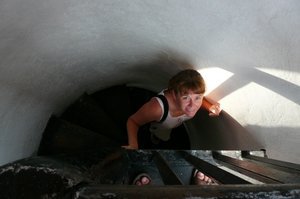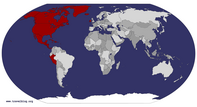Advertisement
Published: March 16th 2009

 Leila´s nose and Chuck´s toes
Leila´s nose and Chuck´s toes
Baluarte Santiago, Veracruz, Veracruz, MexicoThe afternoon of Saturday, March 7th we arrived to the town of Acayucan, Veracruz. Chuck and I paid for a room at the Hotel Arcos del Parque, located across the street from the main square. We paid less than $35 USD for a nice and clean room with air conditioning, cable television, comfortable bed, hot shower, a pool, bar and restaurant, and off-street parking. That evening we noticed our van was four rows deep in the parking lot; good thing we planned to stay two nights because we knew there was no way we would be able to leave at all early the following day. We walked through a Mexican dollar store (same as in the USA), spent some time at the square, and visited the Catholic Church, where Christ was in a casket (although cannot say why).
Next we went to San Lorenzo, one of the ancient Olmec cities. After driving for about an hour down a rough rural road we arrived to the village of San Lorenzo. We were told that there were no ruins and only a local museum a short distance up the road. We drove up the road a short distance
and apparently passed the museum. We asked for direction and were told that we just needed to go back a short distance to locate the museum. Well, we passed it again. This time, a teenage boy brought us to the museum. You should understand the village was only about three blocks in length. The museum was a small white one-room building with the appearance of a typical rural Mexican home. The museum was locked and we were told to wait for the key to come. Soon a small group of people had gathered to look at and talk to the gringos. It was obvious by looking into the building that there were only a couple of Olmec pieces, but the people were friendly and welcoming and we appreciated their hospitality and efforts. And, we thoroughly enjoy opportunities to meet and spend time with local people on a more personal level.
The people we met at San Lorenzo told us that back the way we came, in the next village, was the archaeological site of San Lorenzo. We found the site easy enough, but there were no structures or mounds. Instead it was a small park and museum with a
collection of Olmec monuments and pieces from the immediate area with interpretive and historical information on display.
After the San Lorenzo museums we drove northward towards the city of Veracruz. Along the way we stopped for lunch at a restaurant overlooking Lake Catemaco, a beautiful location surrounded by Volcano San Martin Tuxtla and the mountain range of Santa Marta. From Lake Catemaco we drove to San Andres Tuxtla where we stayed the night at the Posada San Martin, a hacienda type hotel (the cheapest and nicest in town) located about three blocks to the zocalo.
Tuesday the 10th of March we arrived to the coastal town of Veracruz, Veracruz. We pulled into the Holiday Inn and saw that room rates began at about $235 USD. We used the lobby computer and found that rooms could be reserved online for as low as $75 USD. In the end we paid about $80 USD for a king suite with breakfast buffet and a balcony overlooking the pool and the gulf. The following morning we went to visit the baluartes or Spanish forts built during the colonial era.
Baluarte or Fort Santiago was similar to most other forts
we have visited in Mexico in size and appearance. Baluarte Santiago was built during the late 1600s to protect against attack by pirates. The fort now functions as a museum which houses a collection of gold pieces from pre-Hispanic and colonial times.
San Juan de Ulua was by far the largest Spanish fort Chuck and I have visited. The fort consists of a series of buildings the oldest of which was constructed in 1582. In addition to functioning as a fort, San Juan de Ulua has also served as a convent, presidential palace, and prison.
We left the city of Veracruz the morning of Thursday, March 12th and drove to the capital city of Xalapa; just in time for a cold front with a low temperature of 12 degrees Celsius. The newspaper said that the front stretched from Atlanta, Georgia all the way through Veracruz.
We went to Xalapa for the Anthropology Museum, said to be one of the best outside of Mexico City and hoped it would be open (rather than closed for remodeling). We could not find the museum, the traffic was heavy, and we were getting frustrated driving around so we checked into
the Crown Hotel for $100 USD. We walked next store to the Mega (low-mart) and stocked up on breakfast bars. In the morning we walked to the museum; about five blocks from our hotel. We had actually drove right by it the day before (go figure) and concluded we did not find it due to bad signage. The museum was definitely impressive. It covered Veracruz cultural history from the Olmec era through the early 1500s.
Next we drove back towards the coast to La Antigua. This village is home to the so-called House of Cortes, which actually functioned as more of a political and government building. The structure is now in a state of ruin and walking through it was reminiscent of something out of Thoreau. Trees have virtually taken over the building and in some areas the tree roots are more visible than the walls.
La Antigua has a nice town square with a park and Cathedral. Within the Cathedral there were many statues of the Virgin, saints and Christ both on a cross and in a casket; again we do not know the significance.
After La Antigua Chuck and I drove north to
the town of Cempoala to visit the ruins of the same name. By the time we arrived the ruin site was closed and we could not locate a hotel so we filled the van with gas and parked for the night at the local Pemex station. In the morning Chuck noticed that our van was covered with black ash. Cempoala is relatively close, within eyesight, to a factory blowing thick black smoke out of its smoke stacks. Likely this is where the ash came from that covered our van. This cannot possibly be healthy for nearby residents but probably provides jobs; win some and lose some.
The archaeological zone Cempoala featured a small site museum with a collection of ceramic vessels, figurines, and tools. The ruin site included one large plaza surrounded by a handful of structures. The structures at Cempoala were situated according to the four cardinal directions, as were numerous other indigenous American cities. Interestingly, one structure at Cempoala reminded me of the Amphitheater and ball court at Wupatki near Flagstaff, Arizona. According to research at Cempoala, the ring there was used by gladiators. Although there was no ball court at Cempoala, ball court artifacts were found
on site.
Cempoala was founded circa 1200 Common Era by the Totonac culture group. The place name comes from Nahuatl and translates to “place of twenty”. Formerly a market was arranged every twenty days at Cempoala with twenty surrounding communities. After Spaniards arrived to mainland America, Cempoala became an ally of the Spaniards and aided in the defeat of Tenochtitlan. After 1529 the city was virtually abandoned.
Quiahuixtlan, meaning “the place of rain” in Nahuatl, was the next site Chuck and I visited. It is located about an hour drive north of the city of Veracruz. This was quite an impressive site. It is situated atop a hill overlooking the Gulf. Two additional unique features at Quiahuixtlan were the numerous tombs and a natural up-cropping above the site. Chuck says it was a “stick-up” because of how it sticks up in the air. All of the tombs resemble the traditional indigenous houses found throughout Mexico. There were also the remains of two pyramids and a ball court on site. On another note, it was below Quiahuixtlan where the Spaniards established their first settlement in 1519.
The next day we drove to Castillo de Teayo after

 San Lorenzo village Museum
San Lorenzo village Museum
she did not like the gringos, but listened and watched while I sang "estrellita" to herfirst taking a wrong turn and finding ourselves in the neighboring state of Puebla; all part of the daily adventure. In the town of Castillo de Teayo one pyramid remains in the town square. Artifacts from the site reveal influences from the Olmec, Mayan, Toltec, Huastec and Mexica culture groups. It was primarily the Huastecs who occupied the area from circa 1000 Before Common era through to the present day. There is also a small museum adjacent to the square which houses monuments and a variety of other artifacts from the immediate area.
On Sunday the 15th of March we arrived to the city of Tuxpan, located roughly half way between the cities of Tampico and Veracruz. We found a Holiday Inn facing the river and got a pre-open rate for a room of $50 USD, because the official open date does not occur until the coming week. This hotel is definitely original with a combined look of tree house and post-modern simplicity. Really, a nice place.
We plan to stay in Tuxpan for a few days. There is a Cuba museum and an archaeological museum and we are a short drive from the beach (we were
told the sun will come out tomorrow).
After Tuxpan we will make one last stop at Panuco to visit the local Cultural Center which has an exhibition of archaeological Huastec pieces as well as a photographical exhibit that portrays the history of the city. From there we will make our mad dash back into the U.S. of A to be back at home by the last week of March.
For our friends at the Doll House, put the beer on ice because we are stopping there first!
Advertisement
Tot: 0.076s; Tpl: 0.014s; cc: 11; qc: 29; dbt: 0.0455s; 1; m:domysql w:travelblog (10.17.0.13); sld: 1;
; mem: 1.1mb





















